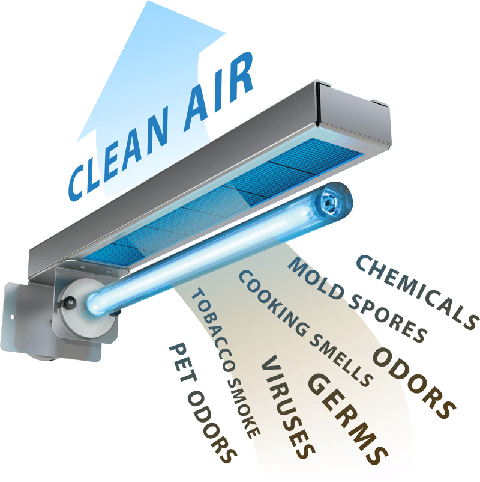
The beautiful flower blossoms of spring increase the presence of particles in the air. When your indoor air is not given the proper attention, it could increase the risks of respiratory illness and allergic reactions. Most households depend on the HVAC system to improve indoor air quality. Unfortunately, it’s easy to forget about HVAC unit maintenance until it malfunctions at the least expected times. When neglected, contaminants can multiply within your unit and recirculate them through the house.
Adding UV lights into your HVAC system is a solution that keeps your unit clean to circulate healthy air throughout your home. Here is a detailed guide that explores UV light facts to clear up some of your concerns and help you make an informed decision.
1. What Is an Indoor Air Quality UV Light?
This is an air-purifying technology that utilizes ultraviolet light to inactivate airborne pathogens, kill viruses, and remove mold and bacteria. There are various UV light indoor air quality products in the market today. Some come as standalone devices, while you can install others directly on your HVAC unit.
Although there might be concerns due to UV rays’ adverse effects, the technician fits UV-based air purifiers deep into the ductwork system away from human contact.
2. How Does It Work?
Convectional air conditioner filters work well in trapping large contaminants particles. However, some microorganisms may slip through the filters into your indoor air. The UV lights help eliminates such pollutants. An HVAC technician installs the UV lamp within the ductwork near the evaporator coil. It then emits germicidal light to act on the air that goes through the ductwork.
The UV light works by attacking and destroying the microorganisms’ DNA. It disrupts their reproductive cycle, which leads to germs elimination. Note that bacteria contain a single cell that relies on DNA to live. If the UV lights destroy the DNA, then it sufficiently damages the bacteria cell rendering it harmless. An efficient cooling system circulates air throughout the home several times. Therefore, the air will receive a disinfection treatment severally each time it passes through the UV lamp.
The indoor coil condenses moisture to lower humidity levels. It creates a perfect breeding site for both molds and bacteria. UV light can sterilize the coils in your air conditioning unit to prevent microbial growth.
Although some UV lights operate on a 24/7 basis, it’s a good idea to invest in the automated UV disinfection system. It enables you to control the amount of UV light applied to lower costs. Such a system efficiently works when installed near the air handler cooling coils. It quickly sterilizes the coils and the air passing through the cooling system. You only turn the UV lights on when needed to save on energy.
3. How Effective Are UV Air Purifiers?
The effectiveness of the UV light air purifying product will depend on various factors. It might vary based on whether the contaminants come into contact with the UV light. Other factors include the bulb’s material, the required light dosage, and the pollutant’s exposure time to the light. If properly designed and correctly fitted into the HVAC unit, the UV can deactivate most bacteria and render the remaining ones inert once they enter the body.
The rays also attack viral cells, eliminating the potential of contracting contagious diseases. Additionally, they eliminate mold and spores. However, bacterial and mold spores are usually very resistant, and you might need high UV light levels and longer exposure time to destroy them entirely.
4. Benefits of Using UV Air Purifiers
Installing UV lights in your HVAC unit helps reduce the threat of airborne illness. The UV lights act as a cleaning agent that eliminates microorganisms in the air, promoting wellness and overall health. It also helps keep the coils in your AC sterilized to prevent re-circulation of airborne pathogens so your household members will experience fewer instances of flu or cold. The ultraviolet light eliminates irritants in the indoor air lowering chances of asthma or allergies. When properly placed, the UV light significantly reduces fungal levels.
It also helps eliminate foul odors in the house. Volatile organic compounds are the primary sources of odors at home. They often lead to eye, nose, or throat irritations, and prolonged exposure can result in dangerous respiratory illness. Some primary VOCs sources in the house include tobacco smoke, cleaning products, paint, and perfumes. UV light can help eliminate volatile organic compounds from your indoors to freshen the air and improve comfort levels.
UV lights also help improve airflow and efficiency. When contaminants clog the parts of your HVAC unit, it will have to work extra hard to maintain the required temperature. It will therefore result in increased wear and tear in your system and higher utility bills. With the proper UV light, it helps eliminate such contaminants to restore your HVAC unit’s capacity. The smooth airflow also translates to fewer repairs, cleaner air, and prolonged HVAC unit lifespan.
5. How to Implement and Maintain UV Light Air Purifiers
Although UV lights can help kill numerous microorganisms, they are only effective when installed correctly. Note that improper installation could cause injury and substandard performance. The installation process involves accessing the ductwork or the coil cabinet. Hence it’s a good idea that you have an experienced technician handle it.
You also need to ensure that your AC undergoes the necessary repair and maintenance before UV light installations. Other times, you might need to replace the AC or add extra components before installing the UV lights into your system. Consult a professional, and they will advise you on the best possible cause of action.
An experienced technician will assess your needs and determine the best area to install the UV light, either at the air handler, ductwork, or the return air. Even after installing the UV light, you should maintain it periodically. The bulbs loosen and lose efficiency after some time, and you should have them checked and replaced annually to preserve the protective benefits of the UV lights.
Also, you should keep the air filters clean to improve your UV light’s performance. When dust accumulates and covers the bulb, it limits the amount of light cast on the flowing air, which reduces its effectiveness. Therefore, change or clean the filters after every three months. If you reside in extremely dusty areas or have a heavily shedding pet, change the filters every month.
Bottom Line
The use of UV light indoor air quality products has increased in recent years due to the desire to maintain safe indoor environments. If you or your house members suffer from breathing issues, allergies, or when you notice higher than usual rates of colds and other viruses, consider installing UV lights. They effectively eliminate pollutants in your HVAC unit or indoor air to create a safe home.
If you need professional help in improving your indoor air quality, reach out to Beltway Air Conditioning & Heating. We have a team of highly trained and experienced technicians serving the Hanover, MD, area. Our company offers a wide range of services, including heating systems and AC installation, repair, and maintenance. We also deal with dehumidifiers and custom ductwork installations. Call us today and schedule an appointment to enjoy our top-notch services.


